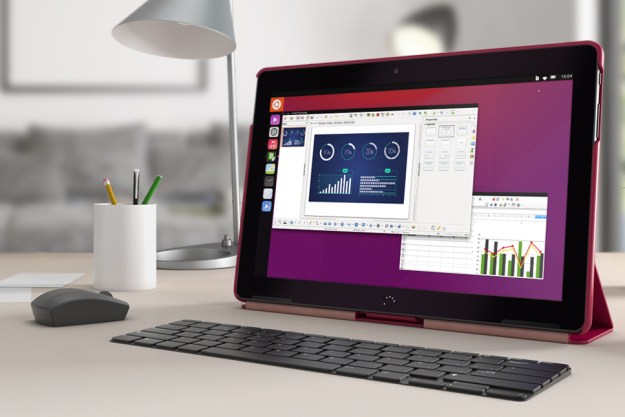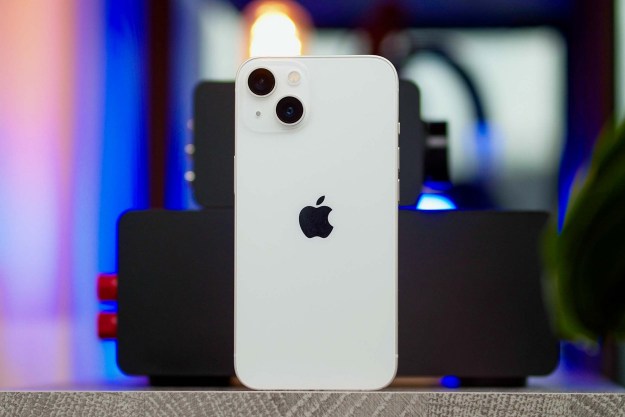
“The world’s first Ubuntu tablet is a disaster.”
- Convergence shows potential
- Lightweight and portable
- Poorly optimized operating system
- Shoddy performance
- Limited output resolution
- Software support is sparse
- Fragile, cheap build quality
When BQ announced back in January that it was coming out with the world’s first Ubuntu tablet, we were excited not only for the prospect of the most widely used Linux kernel being adopted by a tablet maker, but also because its most prominent feature is one that could have knocked Windows off the map for us. A tablet designed specifically with external monitor support in mind? This could be a dream PC.
After months of waiting to finally get the product in our hands, however, we’ve seen a shift in tone concerning the Aquaris M10. A 7,280mAh lithium-polymer battery, 2GB of RAM, 16GB of storage, and a MediaTek quad-core processor might sound appetizing, but the resulting product is bittersweet.
A clever design for an otherwise unexceptional tablet
Weighing in at just over a pound, the Aquaris M10 isn’t an unwieldy tablet, but it doesn’t strike us as lightweight either. It’s definitely a two-hand device, considering the acreage of its 10.1-inch display. Trying to use it with one hand is a sure way to induce wrist cramps and other discomfort.
The Aquaris M10 has a glossy display, while the rear of the device bears a matte finish, allowing for both an improved grip and a more flattering appearance. The device is painted black for the full HD version, while the standard HD version has a bleach white finish. If you were hoping for a higher resolution and the snow-coated exterior, you’ll be hopelessly out of luck.
Our review unit actually started coming apart within days.
Build quality felt solid at first, but the soldering job on the display became a major problem. When the device was held horizontally, towards the bottom of the panel, our review unit started coming apart within days of use. That is certainly not ideal, and surprising to see from what’s supposedly a finished product.
There’s a built-in Wi-Fi 802.11 b/g/n adapter with Bluetooth 4.0, and GPS support also present.
Perhaps the best part of the Aquaris M10’s design is its generous incorporation of ports located on the device. There’s Micro USB, Micro HDMI, a 3.5mm headphone jack, and surprisingly even an SD card slot.
Don’t dare use the Aquaris M10 the way it was intended
While BQ doesn’t usually ship a mouse and keyboard with the Aquaris M10, the company did send us a compatible mouse and keyboard duo for testing the tablet’s signature convergence feature, which lets users switch between tablet and desktop modes for when the device is connected to an external display.
Using a Bluetooth mouse, we noticed the connection frequently timed out, more so than the keyboard, which encountered some of the same issues. While BQ claims that this blatant unresponsiveness will be addressed in a future update, the fact that the tablet is out now, already in the hands of consumers, indicates that concessions were made to get the Aquaris M10’s Ubuntu flavor out on the market.
On the upside, the tablet’s on-screen keyboard is quite nice. All of the keys are bold and vivid, making it accessible to users of all finger sizes. It even features haptic feedback, a subtle, albeit pleasant touch that’s rarely present in a tablet. The sound of the Aquaris M10 vibrating as it’s powered on brings a fleeting thrill ensued by sheer disappointment only moments thereafter.
Display and audio aren’t top of the line, but still acceptable
The 10.1-inch screen on the Aquaris M10 should be more than enough to conduct some basic web browsing, and were this not the Ubuntu Edition being written about, it probably would be. At the center of the Aquaris M10, however, is a full-fledged desktop operating system, one that’s not exactly optimized for a smaller display.
Using the Convergence feature was like asking for an Xbox One, and ending up with socks.
Firefox is virtually unusable without a mouse and keyboard. Even when they’re attached, text is too small to comfortably read. In the case of using the device in tablet mode, because of the display size, users are basically limited to a blatant Safari knock-off bundled with the device, called Browser. Both Firefox and Browser ship pre-installed on the Aquaris M10, but as head of Ubuntu mobile Richard Collins informed us, the default “Browser” will be exclusive to mobile devices for the time being while a desktop version is on the way.
Convergence is a centerpiece of the Aquaris M10 with Ubuntu. It’s an attempt to make the OS work smoothly both on the tablet, and with an external monitor. But using Convergence felt like asking for an Xbox One for Christmas, and ending up with socks. The first thing we noticed is the tablet’s inability to output beyond its native resolution when connected to an external monitor – a rather serious oversight. If you have the full HD version, you’ll be limited to 1,920 x 1,080, while if you opt for the standard edition, you won’t be able to output beyond 1,280 x 8,00 pixels. Who still uses a monitor with that result?
This is especially troublesome if you have a larger, high resolution display you’d like to connect it to. Using a 2,560 x 1,440 HP Envy 32-inch monitor, we noticed a significantly blurrier image than is typical with a desktop PC due to the tablet’s inability to output beyond 1080p.
The quality of the display is about what you would expect from a tablet on a budget. Using the tablet outside is difficult due to the nature of the glossy, touch-screen display, but this should be the least of your concerns if you plan on buying an Aquaris M10: Ubuntu Edition.
While the speaker quality is exactly as we would expect from built-in tablet audio at this point, the maximum volume setting is underwhelming. Compared to an iPad Mini, the Aquaris M10 is soft spoken. In a noisy setting the audio can easily be obstructed by surrounding commotion.
The MediaTek processor is outmatched
Performance is key on any device that makes use of a desktop operating system. Outside of tablet mode, Ubuntu consumes far more resources than Android or iOS, which are designed specifically for mobile devices. Ubuntu is not, and that was clear from the moment we laid our hands on this version of the Aquaris M10.
The ARM-based MediaTek MT8163B processor featured in the Aquaris M10 is capable of exhibiting clock speeds of up to 1.3GHz. Paired with 2GB of RAM and a 600MHz MediaTek Mali-T720 GPU, streaming 1080p video over a fiber optic Internet connection shouldn’t be a challenge.
Thanks to the Ubuntu port for the ARM architecture, however, the Aquaris M10 struggles to keep up even the most basic tasks. Persistent stuttering, out of sync audio, and buffering proved the tablet’s poor software optimization, and the CPU just isn’t quick enough to make up for it through brute force.
There isn’t much more to say about the processor performance on the Aquaris M10. Since we couldn’t get a proper benchmark on the system due to a severe lack of software compatibility on the ARM port of Ubuntu, let’s just say it’s not great.
…But hey, at least you can take it places
As a desktop, convergence makes traveling with the Aquaris M10 a delight. At a little over a pound, or 0.47 kilograms, it’s portable to the point where slipping it into a purse or backpack won’t put much strain on your joints. With that in mind, a cheap ultrabook would have the same effect without the headache of the Aquaris M10’s myriad drawbacks.
As with processing performance, we couldn’t use any official tests to determine the strength of the battery life, though we did use the Aquaris M10 for several consecutive hours last week to type up some pretty intense commands in Terminal. The 7,280 mAh Li-Po battery puts it about on par with other tablets in its price range, and surprisingly, battery life is one area that doesn’t appear to take much of a hit from the Ubuntu operating system.
Lackluster software support proves Ubuntu isn’t ready for tablets
When it comes down to it, the ARM port of Ubuntu is the central core to all of the Aquaris M10’s problems. There are countless reasons my knee-jerk reaction is to compare the device to Microsoft’s Surface RT from 2012.
The performance of the ARM processor, for instance, is hindered by the resources demanded by the OS. This could potentially be improved with some software optimization refinements down the line, though a better solution would be releasing an Aquaris M10 “Pro” tablet with a more compatible architecture.
You can’t even install a program without taking a break to grab a handful of ibuprofen.
As of right now, there’s not even a package installer app on the Ubuntu Store. For those unfamiliar with how Linux works, without a package installer, everything outside of the app store needs to be installed manually, through the command prompt. We spent hours, on a Sunday afternoon, under the guidance of a 10+ year Linux veteran who himself couldn’t even get Geekbench installed. If you’re purchasing the Aquaris M10 under the impression that you’ll have unfettered access to the complete Ubuntu desktop experience, don’t even bother.
Although Canonical, the company behind Ubuntu, plans on adding a wider variety of apps from its x86 operating system to the ARM variant down the line, the current selection is evidently barebones.
A ‘commercially reasonable’ warranty
On top of everything else, the limited warranty that accompanies BQ’s Aquaris M10 tablet is nothing to write home about. Mundo Reader, BQ’s parent company, takes care of “any material, design or manufacturing defects by way of repairing or replacing the Product” for free as long as you let the company know “in a commercially reasonable period of time.” And, according to the BQ Store warranty page, said commercially reasonable period of time is 15 days after delivery. There are no extended warranty options, so if you begin to experience, say, the plastic casing starting to detach itself from the rest of the tablet after a couple of weeks, your best bet is to throw it out the window.
Just go buy an Android tablet
The Ubuntu Edition of BQ’s Aquaris M10 might offer everything you would need from a low-budget tablet if it weren’t for the operating system. Starting at €229.90 (~$260) or €280 (~$315) for the full HD version, it has all the specs that make a great Android device, but it’s ultimately stifled by its own signature characteristic: Ubuntu. Sure, Convergence is remarkable as a concept, but if this tablet is all we have to show for it, it’s better off being left as just that — a concept.
Barring convergence, there’s nothing terribly remarkable to set the Aquaris M10 apart from the competition, and even Convergence is only vaguely differentiated. The Aquaris M10 is a tablet, which does the stuff you’d expect to tablet to do, but it doesn’t do them better than any other, nor is it a remarkable value
If you’re on the market for a nice budget tablet, you might be better off opting for a Dell Venue 8 or a Samsung Galaxy Tab S2, or literally anything on this list before buying the Aquaris M10. The “world’s first Ubuntu tablet” would surely have an audience if it weren’t riddled with inconsistencies. Unfortunately, you can’t even install a program without taking a break to grab a handful of ibuprofen.




